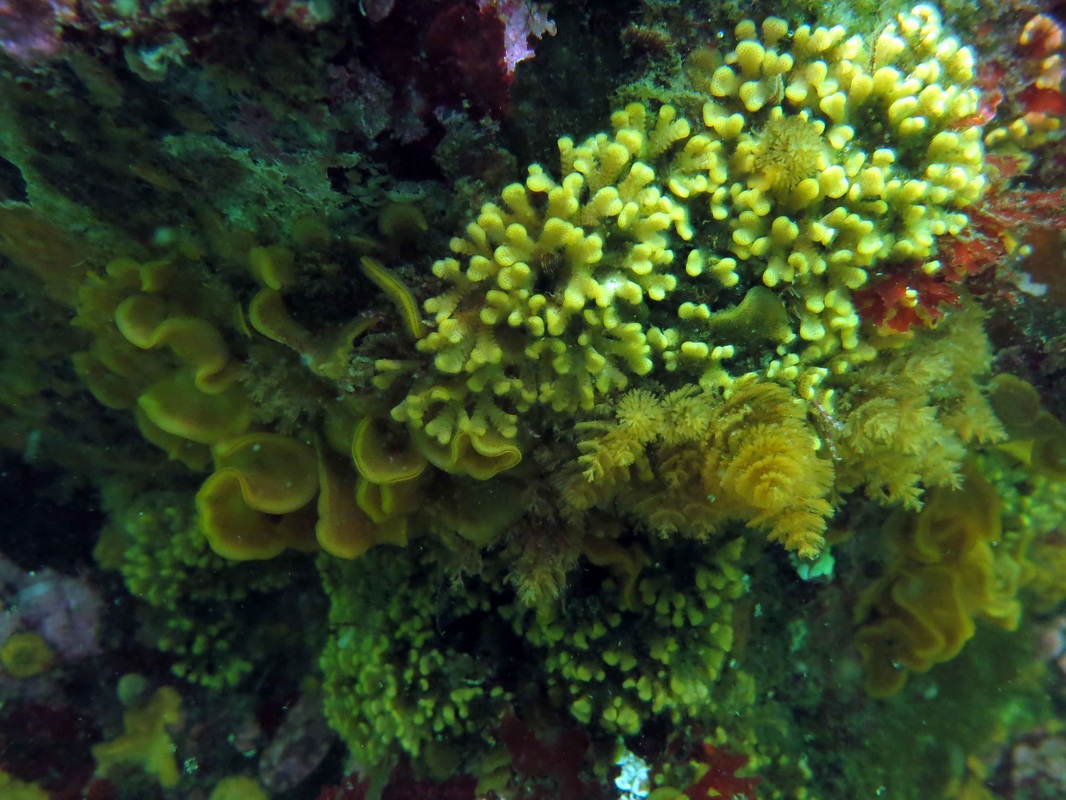Northern staghorn bryozoan, false coral • Heteropora pacifica
Heteropora pacifica is the yellowish lobed bryozoan at centre and top right. Also pictured here are Bugula californica (orangey-brown cone-shaped spirals) and Hippodiplosia insculpta (flattened, wavy-edged bryozoan at left and distantly at bottom right). Photo by Jenn Burt.
Identification
This upright bryozoan forms densely-branched colonies that are coral-like in appearance due to a high level of calcification. The northern staghorn bryozoan's stiff branches are round in cross-section, to 5 mm in diameter, and often connect at points (anastomose). The overall shape of a single colony is rounded and reminiscent of a cauliflower head; these colonies can grow to 10 cm tall and 45 cm across. This bryozoan's colouring is typically yellow or yellowish-green, though it may vary to grey or have a pinkish tinge especially along the branch ends.
Habitat & Range
The northern staghorn bryozoan grows on rock in the very low intertidal and subtidal to 27 m deep. It is most commonly found in exposed locations, and in the right conditions colonies can nearly carpet the bottom. Its range extends from northern Alaska to southern California.
Similar Species
This bryzoan is often mistaken for a coral.
The delicate staghorn bryozoan (Heteropora alaskensis) has thinner, spindly branches and is less dense than the northern staghorn bryozoan.
iNaturalist
https://www.inaturalist.org/taxa/465163-Heteropora-pacifica
This upright bryozoan forms densely-branched colonies that are coral-like in appearance due to a high level of calcification. The northern staghorn bryozoan's stiff branches are round in cross-section, to 5 mm in diameter, and often connect at points (anastomose). The overall shape of a single colony is rounded and reminiscent of a cauliflower head; these colonies can grow to 10 cm tall and 45 cm across. This bryozoan's colouring is typically yellow or yellowish-green, though it may vary to grey or have a pinkish tinge especially along the branch ends.
Habitat & Range
The northern staghorn bryozoan grows on rock in the very low intertidal and subtidal to 27 m deep. It is most commonly found in exposed locations, and in the right conditions colonies can nearly carpet the bottom. Its range extends from northern Alaska to southern California.
Similar Species
This bryzoan is often mistaken for a coral.
The delicate staghorn bryozoan (Heteropora alaskensis) has thinner, spindly branches and is less dense than the northern staghorn bryozoan.
iNaturalist
https://www.inaturalist.org/taxa/465163-Heteropora-pacifica
References
Adams, M. J. (2008). Heteropora pacifica (Northern Staghorn Bryozoan). Beach Watchers. Washington State University. Accessed 13/10/2015.
Cowles, D. (2007). Heteropora pacifica Borg, 1933. Invertebrates of the Salish Sea. Rosario Beach Marine Laboratory. Accessed 13/10/2015.
Lamb, A., and Hanby, B. (2005). Marine Life of the Pacific Northwest [electronic version]. Madeira Park, BC: Harbour Publishing.
McDaniel, N. Heteropora pacifica Borg, 1933. In Klinkenberg, Brian. (Ed.) E-Fauna BC: Electronic Atlas of the Fauna of British Columbia. Lab for Advanced Spatial Analysis, Department of Geography, University of British Columbia, Vancouver. Accessed 13/10/2015.
Authors and editors of page
Kelly Fretwell (2015).
Adams, M. J. (2008). Heteropora pacifica (Northern Staghorn Bryozoan). Beach Watchers. Washington State University. Accessed 13/10/2015.
Cowles, D. (2007). Heteropora pacifica Borg, 1933. Invertebrates of the Salish Sea. Rosario Beach Marine Laboratory. Accessed 13/10/2015.
Lamb, A., and Hanby, B. (2005). Marine Life of the Pacific Northwest [electronic version]. Madeira Park, BC: Harbour Publishing.
McDaniel, N. Heteropora pacifica Borg, 1933. In Klinkenberg, Brian. (Ed.) E-Fauna BC: Electronic Atlas of the Fauna of British Columbia. Lab for Advanced Spatial Analysis, Department of Geography, University of British Columbia, Vancouver. Accessed 13/10/2015.
Authors and editors of page
Kelly Fretwell (2015).





